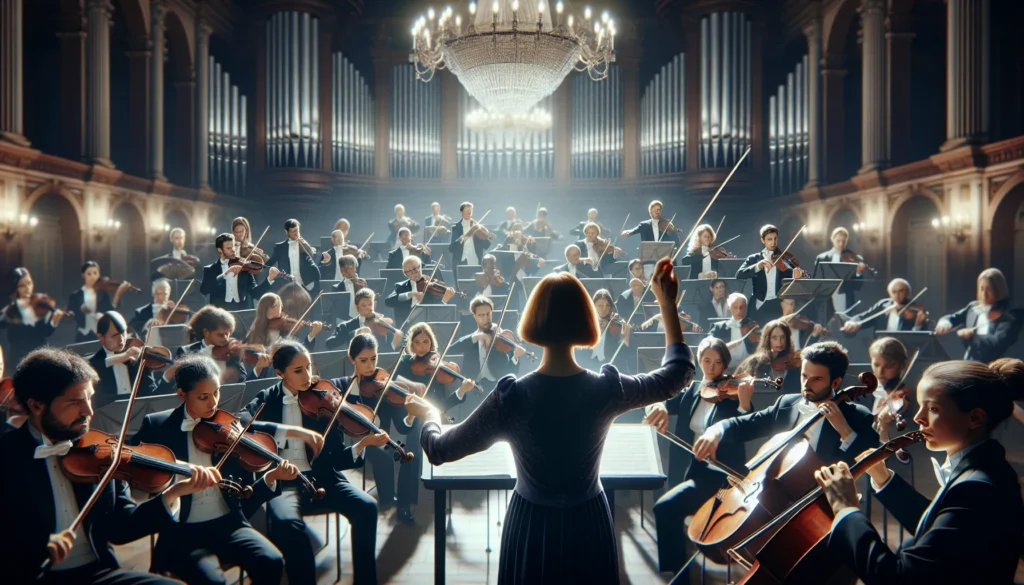Table of Contents
ToggleClassical orchestra music isn’t just for stuffy concert halls and tuxedo-clad musicians. It’s a vibrant world where emotions dance and stories unfold, all without a single word. Imagine being swept away by the soaring strings or the thunderous brass, as if the music itself is giving you a bear hug. Whether you’re a seasoned aficionado or just curious about what all the fuss is about, there’s something undeniably captivating about the rich tapestry of sound that an orchestra weaves.
Overview Of Classical Orchestra Music
Classical orchestra music encompasses a vast repertoire, ranging from orchestral symphonies to chamber music. This genre showcases the collaboration of various instruments, including strings, woodwinds, brass, and percussion, each contributing unique timbres and textures. Composition techniques used by renowned composers, such as Beethoven and Mozart, highlight intricate arrangements that evoke a broad spectrum of emotions.
Concert halls often host performances, allowing audiences to experience the auditory beauty firsthand. Renowned orchestras worldwide, including the Vienna Philharmonic and the Berlin Philharmonic, dedicate themselves to preserving and interpreting classical works. Performances typically feature both soloists and full orchestral ensembles, enhancing the richness of the music.
Orchestral music serves multiple purposes, including entertainment, education, and cultural expression. Various compositions draw inspiration from historical events, literature, and personal experiences, creating deep narratives through sound. For example, Tchaikovsky’s “1812 Overture” captures the intensity of battle through its dramatic crescendos and dynamic contrasts.
Festival performances offer opportunities for exposure to fresh talent and innovative interpretations. The pieces performed often reflect the evolving nature of classical music, integrating modern influences while respecting traditional roots. Engaging programs and thematic concerts attract diverse audiences, fostering a greater appreciation for orchestral music.
Instructors and educators often utilize classical compositions in music education, introducing students to fundamental techniques and concepts. Through listening and performance, learners gain insight into the intricacies of orchestral arrangement and interpretation. This educational aspect further solidifies classical orchestra music’s significance in cultural and artistic landscapes.
Historical Development
Classical orchestra music has a rich history that dates back several centuries. Its evolution reflects changing musical styles and societal influences.
Origins Of Orchestra Music
The roots of orchestra music trace back to antiquity, with early ensembles formed in ancient Greece and Rome using strings and percussion. During the Renaissance, these ensembles expanded in size and complexity, integrating woodwinds and brass instruments. The Baroque period marked a significant transition, as composers like Bach and Vivaldi crafted sophisticated compositions for larger orchestras, leading to the establishment of ensemble norms. The evolution into the classical orchestra set the foundation for the genre.
Evolution Through The Ages
Throughout the 18th and 19th centuries, orchestral music underwent substantial change. The Classical period introduced a clearer structure and balance, with composers such as Mozart and Haydn shaping sonata form. The Romantic era further enhanced orchestral sound, emphasizing emotional expression and exploration of new harmonies. Composers like Tchaikovsky and Mahler expanded orchestration techniques, adding diverse instruments to create richer textures. Twentieth-century innovations embraced dissonance and non-traditional structures, maintaining orchestral relevance while prompting new interpretations.
Key Composers And Their Works
Classical orchestra music features a rich tapestry of composers who have made significant contributions to the genre. Their masterpieces invite listeners to explore diverse emotions and intricate arrangements.
Notable Classical Composers
Beethoven stands out for his innovative symphonies, revolutionizing the structure of orchestral music. Mozart’s operas and symphonies showcase remarkable melodies and harmonies, illustrating his genius. Tchaikovsky captivates audiences with his emotional depth, especially in “Swan Lake” and “The Nutcracker.” Bach’s concertos and suites highlight counterpoint and intricate structures, reflecting his mastery in composition. Mahler blends symphonic size with profound themes, creating an immersive experience in works like “Symphony No. 5.” Each composer uniquely contributes to the evolution of classical music, making their works essential for understanding the genre.
Iconic Orchestra Pieces
The “Symphony No. 5” by Beethoven stands as an iconic representation of the struggle and triumph of the human spirit. Mozart’s “Eine kleine Nachtmusik” offers delightful contrasts in mood and melody, frequently performed in concert halls worldwide. Tchaikovsky’s “1812 Overture” combines traditional melodies with powerful orchestration, commemorating historical events. Bach’s “Brandenburg Concertos” showcase a blend of different instruments, highlighting Baroque innovation. Mahler’s “Symphony No. 2,” also known as the Resurrection Symphony, leaves a lasting impression with its grand scale and emotional resonance. These works exemplify the depth and versatility of classical orchestra music, continuing to inspire musicians and audiences alike.
Elements Of Classical Orchestra Music
Classical orchestra music comprises various elements that contribute to its richness and complexity. Understanding these elements enhances appreciation for the genre.
Instrumentation And Roles
Instrumentation plays a crucial role in the orchestral sound. Strings, woodwinds, brass, and percussion form the core sections of the orchestra. Each section serves a specific role; strings provide melodic foundations, while woodwinds add color and character. Brass instruments contribute power and brilliance, often carrying the main themes. Percussion adds rhythmic depth and accentuates dynamics. Collaborative performance allows for intricate dialogues among instruments, demonstrating distinct timbres and textures that evoke a wide range of emotions.
Structure And Form
Structure defines the organization within classical compositions. Common forms include symphonies, concertos, and chamber music. Symphonic works typically consist of multiple movements, often following the sonata-allegro form, which features exposition, development, and recapitulation. Concertos typically highlight a solo instrument against the orchestral backdrop, showcasing virtuosic capabilities. Chamber music often involves smaller ensembles, emphasizing intimate interactions among musicians. Each form presents unique compositional techniques, allowing composers to explore themes and variations while engaging the audience in a dynamic experience.
Ending The Experience
Attending a classical orchestra performance concludes with a profound impact on audiences. The final notes often leave listeners in silence, reflecting on the emotional journey experienced throughout the concert. Each composition resonates differently, creating personal connections to the music.
After the last piece, orchestras frequently receive applause, showcasing appreciation for the musicians’ dedication. Performers may acknowledge the audience before exiting the stage, highlighting the shared bond formed during the evening. A well-executed finale, whether a dramatic climax or a gentle resolution, can evoke powerful emotions.
Audience members often discuss their favorite moments with friends or family after the concert, exchanging insights about interpretations and feelings. Engaging in conversations deepens their understanding of the music. Recollecting the performances can spark interest in exploring other works by the same composers or similar genres.
This experience may inspire attendees to seek out future concerts or dive into recorded performances, expanding their appreciation for classical music. Online platforms and local events provide various opportunities for continued exploration. As people revisit their favorite pieces, they may uncover new interpretations or arrangements that further enrich their connection to the genre.
Such encounters ensure the lasting relevance of classical orchestra music in today’s cultural landscape. The shared experience of live music fosters community and conversation, emphasizing that orchestral works are not just historical artifacts. They remain vibrant and integral to modern artistic expression.
In this way, the emotional connection established during a performance lingers long after the final bow.
Classical orchestra music continues to resonate deeply with audiences around the world. Its ability to evoke a spectrum of emotions and tell compelling stories through sound remains unmatched. As both a historical art form and a modern expression, it bridges generations and cultures.
The transformative experience of attending a live performance fosters connections that enrich listeners’ lives. With each concert, audiences discover new interpretations and fresh talent, ensuring that the legacy of classical music thrives. This genre’s enduring appeal lies in its capacity to inspire and elevate the human experience, making it a vital component of cultural heritage.





